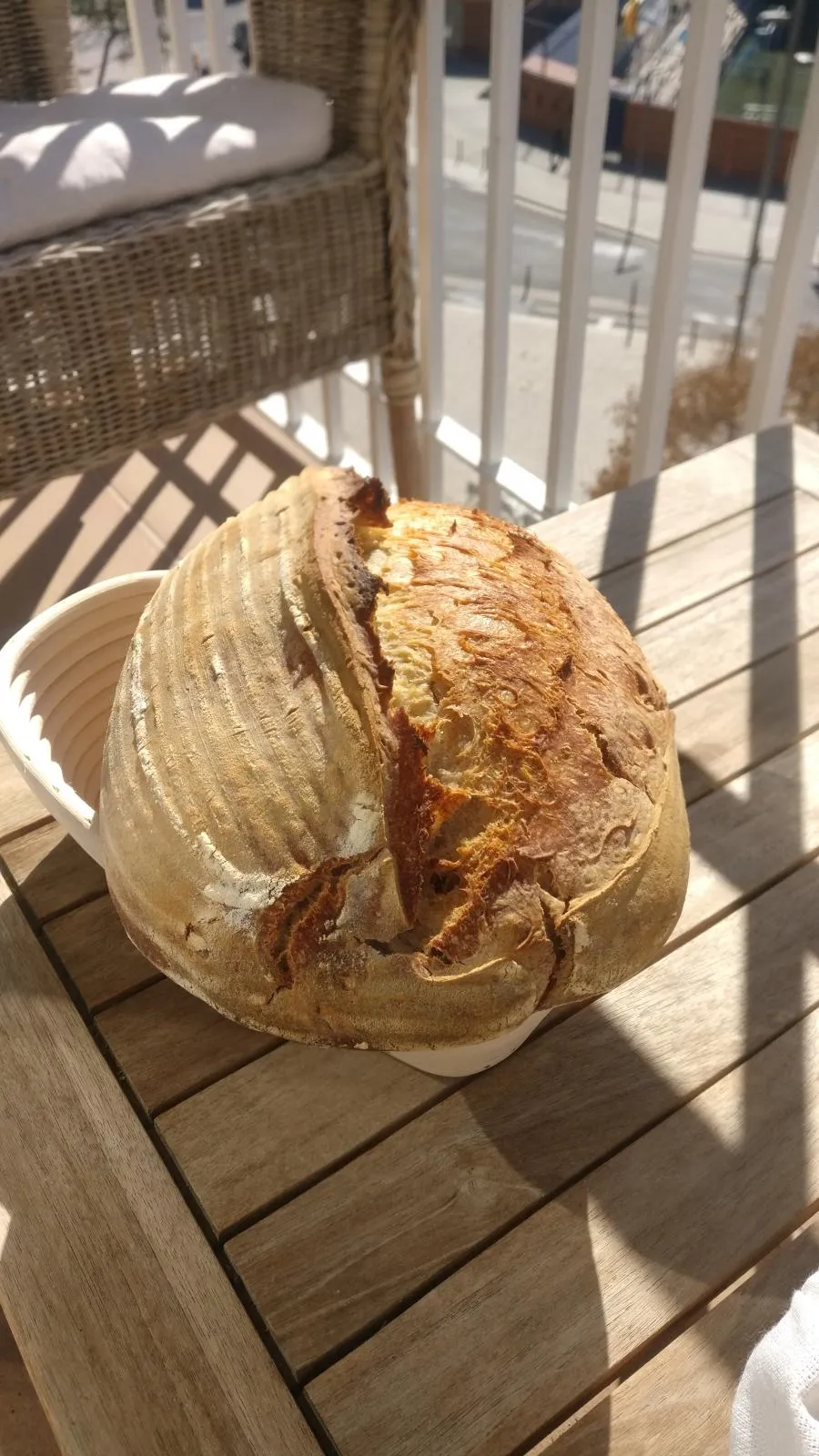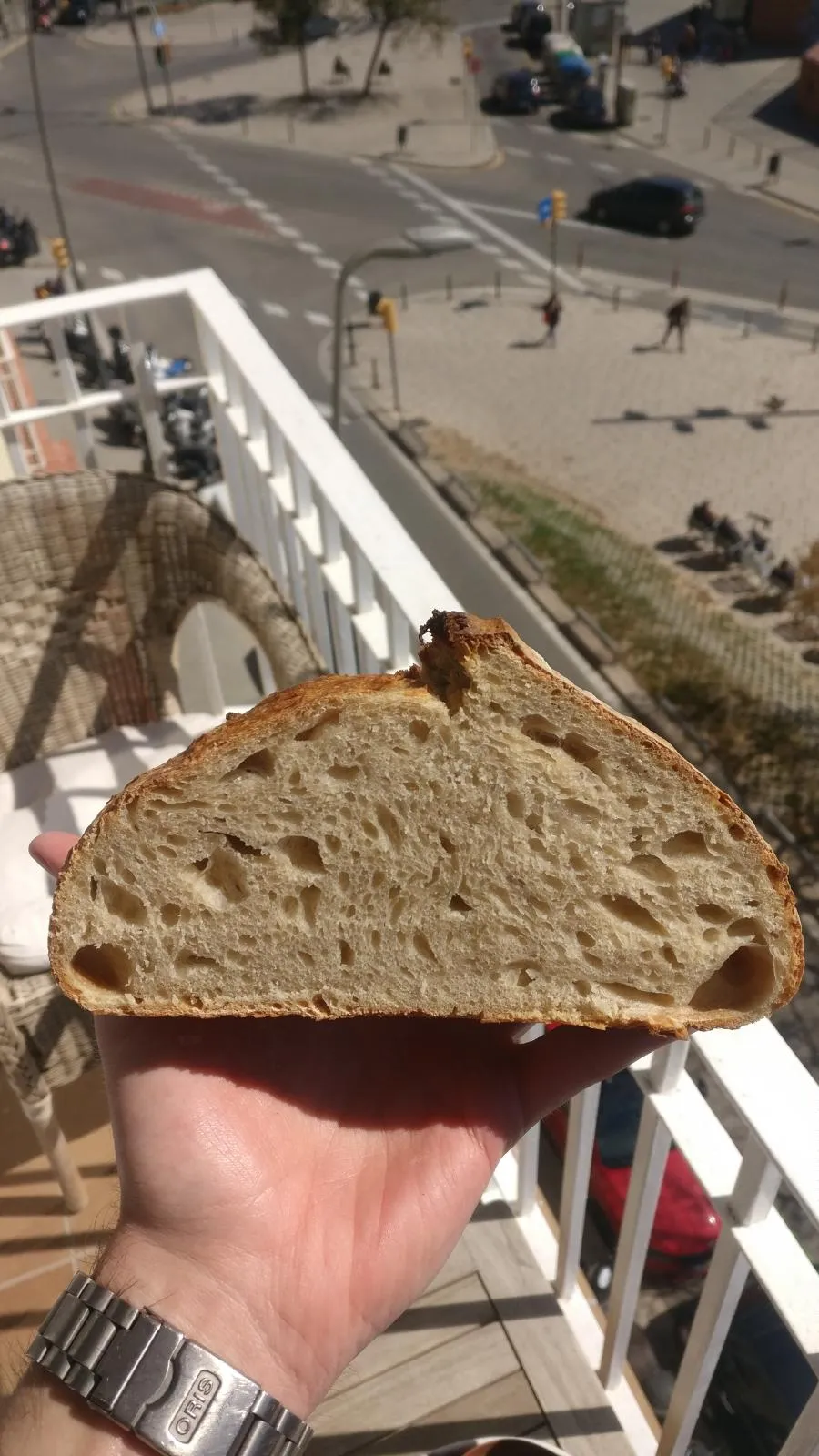Hi guys, I've been baking soudough for a year now and I can say I got the hang of it. I get nice oven spring and good crumb. The only thing I still have to figure out, is why I'm getting this dusty crust instead of a golden brown one.
I typically bake 2 loafs at a time (20 min with no convection and with steam (roasting pan with water) and 20-30 min without steam). (I also have a dutch oven but it would take double the time to bake them, so...). If someone has suggestions about what the problem could be, let me know.
Image

What temperature?
About 225 °C (440 Fahrenheit).
That helps a lot!
If your bread was flat and lacked oven spring one might think it fermented too long and exhausted the flour. But that does not look the case.
I suspect your flour. What type are you using?
If it lacks malt, you would do well to add 0.5% Diastatic Malt to your mix. This should help. You might want to increase it to 1% if the bread darkens but still is not dark enough. Be careful to not use too much Diastatic malt, because the crumb will get gummy (A Bad Thing).
Many of the flours in America add small amounts of Diastatic Malt to their flours.
I'm using a regular strong bread flour (12,7% protein). Now that you mention it, I might be overfermenting the dough a bit. And no, I don't think it has any kind of malt in it. Is it some type of sugar? Here is a photo of the crumb.
Image

Overfermentation is not the problem. It rose too well for that.
Try 0.5% Diastatic Malt. That should make all the difference. DM is a type of sugar.
I will give it a go, thanks! If I can not find DM I suppose I can use any other sugar ?
The other thing that I was thinking it could be the issue is not enough vapor? In my next batch I'll bake one with my dutch oven to see if there id any difference .
This malt is what you ideally want.
https://www.amazon.com/s?k=Diastatic+Malt
If you have a “Home Brew” store near you they should have something you can use, but you want “Diastatic” Malt, not Non-Diastatic.
Your best bet is get the proper stuff.
with only a cup of water in the steam pan and remove it when rotating the loaves. Make sure the oven is fully preheated when the loaves go in. Might put an oven thermometer in the oven to double check the temp. Often this is caused by the oven being too cool at the start of the bake but it remains a mystery in many cases. A quick brush of oil or butter on the dusty crumb can restore some colour.
Thanks for the reply, I will up the initial temperature a bit, and see what that does.
or from too much steam but I think your oven temp is falling and is slow to recover. I would start with a hotter oven to dry and bake the crust.
Yes I will try a hotter oven. Maybe you are right that two at a time is the problem.
You have too much flour on the surface of your loaf and banneton. Try shaping it on a clean table surface and brush the excess of flour off the surface of your loaf with a soft brush before sending it to oven to bake.
Hey thanks for the reply. I don't think thats the issue in my case, I belive they didnt have too much flour on top. They just turned to that color... after they rose.
I had a similar issue due to the clay baker I was using --- despite every attempt to spray and minimize dusting. I'm fairly sure now that it was due to a poor fit of the lid in the baker and a corresponding inability to retain steam properly (despite attempts at aggressive spraying). How tight is the fit on your roasting pan? If you place the top and bottom on a flat countertop does each one feel flush, or does it rock slightly? Have you tried using your dutch oven (perhaps with a spray bottle) for single loaf bakes for comparison? I expect most dutch ovens will seal well.
I don't have a particularly controlled direct comparison, but the following is typical of the dull crust I often got in the previous baker (minimal or no dusting flour and use of spray bottle before covering):
This is a more recent crust after changing my baker:
There are good comments in this thread, but I wanted to add this note since all of your efforts will be in vain if the baker (or oven) you are using does not retain steam well.
Hey, thank you for the reply. In this bake, I didn't use any kind pan to cover the loafs. I just turned the convection off, and added a pan with water at the bottom of the oven. I do have a dutch oven and I will use it it my next bake to see what changes it does. It is just more time consuming since I have to bake one after the other.
Are you in Australia? Are you using a gas oven?
Using a gas oven, even with steam, can produce the dull crust,
Also, using convection mode, even after steaming, can sometimes dry out the crust if the fan is blowing too fast.
--
look at the official ingredients list on your flour's packaging. Does it include any of the following: amylase, malted wheat flour, malted barley flour? If not, then you need to add diastatic malt if you are doing a North American recipe. North American formulas assume use of malted white flour.
--
If you are in .au ...
Here is a web site specifically for Australian bakers: https://www.sourdoughbreadrecipe.com.au
Based on this web page, some Australian bread recipes do require diastatic malt:
https://www.sourdoughbreadrecipe.com.au/methods/how-to-make-a-bread-dough/
The malt is in step 5 where the water is added.
These two pages talk about Diastatic malt powder:
- - - https://www.sourdoughbreadrecipe.com.au/ingredients/
- - - https://www.sourdoughbreadrecipe.com.au/slider/malt-flour-for-sourdough-diastatic-or-non-diastatic/
--
Here is an australian recipe that calls for a pinch of diastatic malt, and some stoneground (presumably whole grain) flour which adds some bran and its attendant enzymes.
https://www.sourdoughbreadrecipe.com.au/recipes/sourdough-baguettes/
--
it looks like they can help you here:
https://www.sourdoughbreadrecipe.com.au/ask-a-question/
Thank you for your reply! I live in Barcelona and my oven is an electric one. What you mention about convection after the steam is released is interesting. I do switch convection for the final part of the bake, I will try baking without convection for the whole bake, see if that helps. Also, no, my flour doesn't have malt or anything like that. I had some replies suggesting diastatic malt , so I will check it out too :)